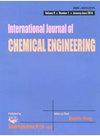在溶气浮选工艺中使用阳离子表面活性剂有效去除水溶液中的布洛芬
IF 2.4
4区 工程技术
Q3 ENGINEERING, CHEMICAL
引用次数: 0
摘要
本研究论文的重点是利用溶气浮选工艺去除水溶液中的非甾体抗炎药物布洛芬。通过比较不同类型的阳离子表面活性剂,如十六烷基三甲基溴化铵(CTAB)、四丁基溴化铵(TBAB)和辛基三甲基溴化铵(OTAB),研究了如何有效去除这种具有生态毒性的药物活性化合物。这项工作包括压力、接触时间、表面活性剂用量、pH 值、流速和初始浓度等影响参数,以达到最佳优化条件。在初始浓度为 50 mg L-1 和 pH = 4 的条件下,CTAB 在 15 分钟内的去除率最高,达到 96.09%;TBAB 在 45 分钟内的去除率为 62.36%;OTAB 在 30 分钟内的去除率为 89.6%。优化后的 CTAB 用量为 0.6 克,TBAB 用量为 1.2 克,OTAB 用量为 1.0 克,去除率更佳。据观察,表面活性剂的几何形状对污染物的去除效率影响更大。将 CTAB 和 OTAB 结合使用,可以获得最佳的污染物去除率。协同效应增强了基于表面活性剂的发生作用,从而更好地形成良好的发泡效果,临界胶束浓度(CMC)也更低。从动力学模型的评估来看,伪二阶浮选动力学最符合实验数据。此外,利用气相色谱-质谱法鉴定出的所形成的代谢物的毒性低于母体化合物。本文章由计算机程序翻译,如有差异,请以英文原文为准。
Effective Removal of Ibuprofen from Aqueous Solution Using Cationic Surface-Active Agents in Dissolved Air-Flotation Process
This research paper focuses on the removal of the nonsteroidal anti-inflammatory drug, ibuprofen, from an aqueous solution using a dissolved air flotation process. The comparison of different types of cationic surface-active agents such as cetyltrimethyl ammonium bromide (CTAB), tetrabutyl ammonium bromide (TBAB), and octyltrimethyl ammonium bromide (OTAB) have been employed to scrutinize the effective removal of the ecotoxic pharmaceutically active compound. The work included the influencing parameters such as pressure, contact time, surfactant dosage, pH, flow rate, and initial concentration owing to the best-optimized conditions. The maximum removal rate of 96.09% was achieved at 15 min for CTAB, TBAB had 62.36% at 45 min, and 89.6% was obtained for OTAB at 30 min, with 50 mg L−1 as the initial concentration and pH = 4. The removal rate was better with the optimized dosage of CTAB at 0.6 g, TBAB at 1.2 g, and OTAB at 1.0 g. It was observed that the geometric shape of the surface-active agents had greater impacts on the contaminants’ efficiency. CTAB and OTAB were combined to find out the best possible removal rate of contaminants. The synergistic effect augments surfactant-based occurrence to be better in forming a good foaming effect and tends to have a lower critical micelle concentration (CMC). From the evaluation of kinetic models, pseudo-second-order flotation kinetics fitted the experimental data best. Furthermore, the formed metabolites that had been identified using gas chromatography-mass spectrometry were found to be less toxic than the parenting compounds.
求助全文
通过发布文献求助,成功后即可免费获取论文全文。
去求助
来源期刊

International Journal of Chemical Engineering
Chemical Engineering-General Chemical Engineering
CiteScore
4.00
自引率
3.70%
发文量
95
审稿时长
14 weeks
期刊介绍:
International Journal of Chemical Engineering publishes papers on technologies for the production, processing, transportation, and use of chemicals on a large scale. Studies typically relate to processes within chemical and energy industries, especially for production of food, pharmaceuticals, fuels, and chemical feedstocks. Topics of investigation cover plant design and operation, process design and analysis, control and reaction engineering, as well as hazard mitigation and safety measures.
As well as original research, International Journal of Chemical Engineering also publishes focused review articles that examine the state of the art, identify emerging trends, and suggest future directions for developing fields.
 求助内容:
求助内容: 应助结果提醒方式:
应助结果提醒方式:


